A great landing page and website should not only captivate your audience but also effortlessly guide them to take action. How do you create a web page that does this? With the powerful partnership of CRO and UX.
Conversion rate optimization (CRO) is the art of fine-tuning your website and landing page to encourage visitors to complete desired actions. And UX, the science of crafting delightful user interactions with your product or service, together form an irresistible duo that makes your website much more meaningful.

As businesses strive to achieve high-impact conversions and boost their online presence, this dynamic combination is increasingly becoming a must-have strategy.
So, what is it about this perfect pairing that makes it so effective for driving conversions? We’re about to delve into the world of CRO and UX, exploring the core principles, their differences and similarities, and proven strategies that will help you optimize your website and increase conversions significantly.
Before we start talking about how to implement specific strategies, understanding CRO and UX in detail will help you tailor these approaches to your business goals and audience preferences.
CRO is the systematic process of increasing the percentage of website or landing page visitors who complete a desired action. These actions can range from making a purchase to filling out a form. CRO aims to make it as easy as possible for your visitors to take action by understanding user behavior, pinpointing any potential barriers, and making improvements.
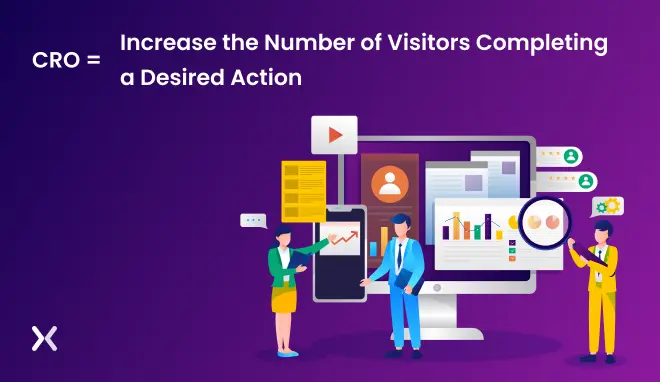
The core of CRO lies in specific actions that website and landing page visitors take rather than just metrics like traffic or bounce rates. It means identifying actions that drive a certain goal and optimizing your site to increase visitors’ likelihood of taking those actions.
To do this, business owners must use specific key performance indicators (KPIs) as well as continuously test and make changes to their site’s design and content. A/B testing can be a great tool to compare the performance of different elements on your landing page and website.
UX is all about the overall experience a user has while interacting with your product or service. The strategy focuses on designing your website and landing page to make it visually appealing, smooth to navigate, and intuitive.

To achieve a stellar UX, it’s all about adopting a user-centric approach. Designers need to consider color schemes, website layout, typography, and navigation, potentially doing user research and creating user personas to help. The ultimate goal of UX design is to create a seamless and engaging experience for users, keeping them on your site longer and returning for more.
This table might help to illustrate each aspect of CRO and UX.
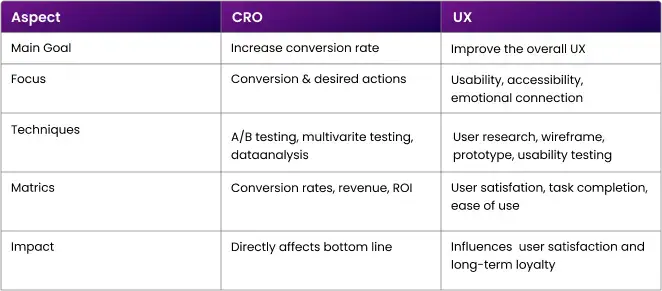
The relationship between CRO and UX is symbiotic, with both strategies complementing and enhancing each other to create an immersive and effective online experience. While CRO focuses on optimizing specific actions and driving conversions, UX takes a more holistic approach, addressing the entire user journey from start to finish.
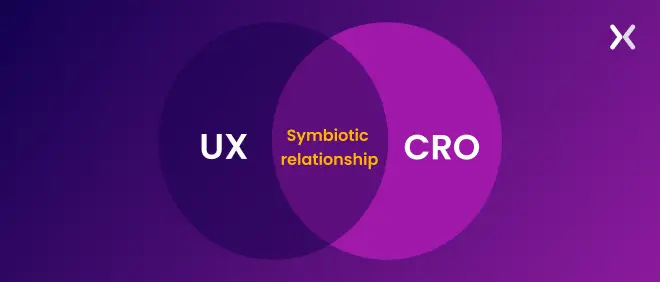
By joining forces, CRO and UX work together to not only increase the chances of users taking desired actions but also to provide an enjoyable and memorable experience. A strong UX is a foundation for a successful CRO, while CRO refines and fine-tunes the user experience to achieve the highest possible conversion rates.
Understanding the unique characteristics of CRO and UX and how they intersect will help you harness their full potential. Let’s explore the distinct features and common ground shared by these two components of website optimization.
While CRO is laser-focused on analyzing user behavior, UX takes a broader view, addressing the entire user journey and working to create a complete experience. CRO often involves refining elements like calls-to-action, headlines, and layout to maximize conversions. At the same time, UX design entails developing a user-friendly interface, intuitive navigation, and accessible content to cater to the needs and preferences of your audience.
CRO is a continuous process that involves ongoing testing, analysis, and optimization of landing page and website elements to improve conversion rates over time. On the other hand, UX design typically requires an initial investment of time and resources to establish a solid foundation, followed by periodic updates and changes to maintain a a high-quality user experience.
CRO and UX have distinct yet interconnected objectives. The goal of CRO is to increase the number of conversions, directly impacting a business’s revenue. UX aims to provide users with a positive and engaging experience, fostering brand loyalty and encouraging repeat visits.
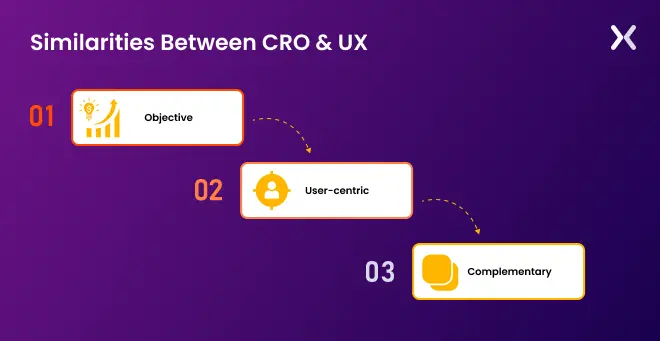
Both CRO and UX share a common objective - to improve the overall experience of a web page. These strategies work together to create a seamless online environment and improve conversions.
At their core, both CRO and UX are user-centric strategies. They prioritize understanding the target audience’s needs, preferences, and behavior to create tailored experiences that resonate with users.
CRO and UX are complementary strategies that work hand-in-hand, combining their strengths. Insights from CRO tests can be used to improve the user experience, which can then be optimized to improve overall performance.
In this section, we’ll uncover the fundamental concepts that underpin each concept.
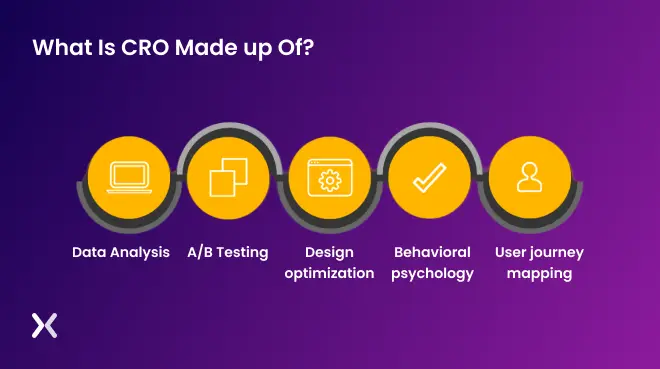
Data analysis: CRO relies on data analysis from page analytics, heat maps, and user surveys to identify areas of improvement and measure the impact of optimization efforts.
A/B testing: A/B testing compares different variations of website and landing page elements to determine which performs best in driving conversions or other metrics.
Design optimization: It involves refining design elements, such as calls-to-action and layout, to maximize user engagement and encourage desired actions.
Behavioral psychology: Behavioral psychology concerns leveraging the psychological factors influencing user behavior, such as cognitive biases, emotional triggers, and more, to craft effective marketing messages.
User journey mapping: Such maps help visualize and optimize the path visitors take on your website, identifying areas where users might see friction preventing and dismantling their conversion.
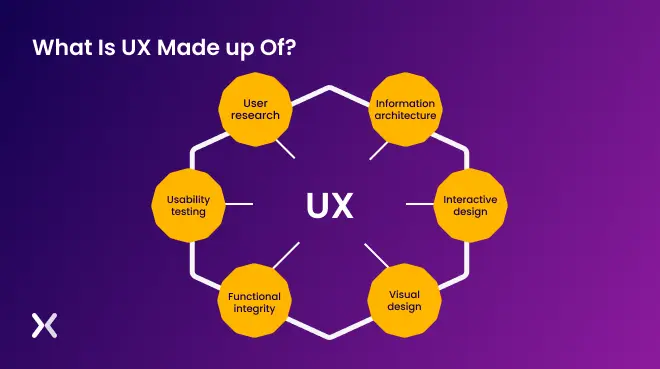
User research: User research gathers insights into a target audience’s preferences, motivations, and behavior through techniques like surveys.
Information architecture: UX structures and organizes information to create a logical, easy-to-use website and landing page layout through techniques such as card sorting.
Interactive design: This type of design emphasizes the utilization of interactive elements that engage users and facilitate smooth interactions with the site.
Visual design: Visual design is all about the aesthetics of a web page, such as imagery, color schemes, space, alignment, and more.
Functional integrity: The functional integrity of a website or landing page concerns features and components working together behind the scenes to craft a satisfying user experience.
Usability testing: This iterative process is integral to UX, as it tests the digital product with real users, helps gather user feedback, and refines the experience overall.
Every business is unique, and so is its audience. Best practices, in general, usually come from generalized observations and trends, which might not necessarily apply to your specific niche, target market, or user base. Adopting these practices without considering your unique context can lead to less-than-optimal results or even backfire, causing confusion or frustration for you and your users.
While CRO and UX best practices can provide a helpful starting point for optimizing your website and landing page, recognize that their effectiveness is often limited. Blindly applying these practices without considering the unique context of your business, audience, and competitive landscape might only yield slight bumps in performance instead of the substantial improvements needed to stay ahead.
This graph by Hotjar captures the process.
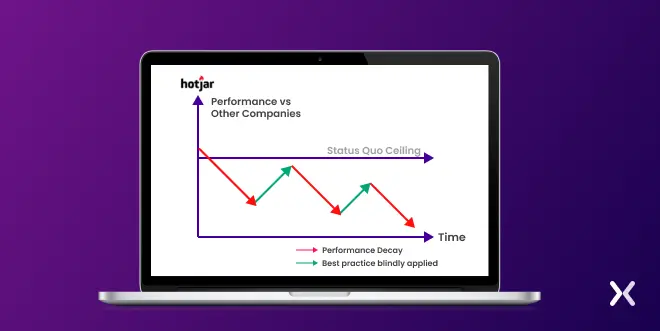
The main reason behind this limited impact is that best practices often represent industry averages or generic recommendations rather than being tailored to your target audience’s specific needs and preferences. And as other companies adopt the same best practices, the performance gap between your site and your competitors narrows, resulting in a declining advantage.
Since CRO and UX are heavily centered on the user, halfheartedly adopting best practices is usually ineffective.
So, what’s the ideal approach?
Integrating UX into your CRO process requires skillful coordination of diverse elements. Here are the steps to successfully combine these two strategies:
Before even touching on design development, UX research typically comes first for many agencies. Using customer interviews, surveys, and usability testing, a UX research team seeks to understand the ‘why’ behind all of their action.
If you’re implementing UX research for CRO, it has become much easier as many tools can help enhance the understanding of user data. Scroll maps, visitor recordings, and eye-tracking heatmaps provide valuable insights into the overall page design, while Google Analytics gives us a deeper understanding of user journeys.

In the realm of UX research, the key is to go beyond merely collecting data and delving into the heart of the matter – the “So What?” aspect. This vital step entails not just gathering insights through surveys, customer interviews, and usability testing but also interpreting their implications for your website and landing page’s design and conversion goals, be it for a SaaS’s free trial, demo booking, or a product’s purchase.
Ex-McKinsey consultant Ameet Ranadive wrote about a question frequently used at McKinsey, “Where’s the ‘So What?” This question works to transform raw data into actionable insights that drive meaningful improvements in user experience and conversions.
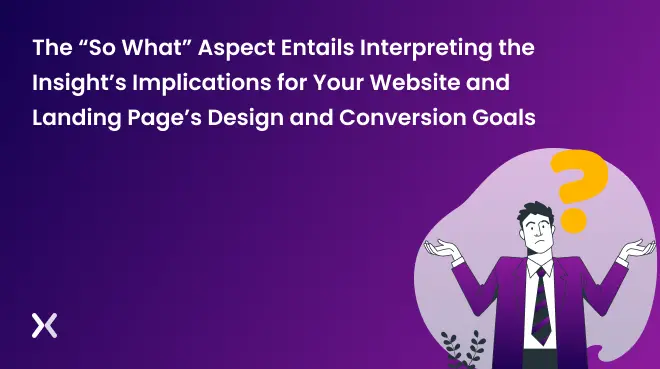
For instance, 30% of the page traffic clicks on the logo at the top of the landing page. This is what the report says.
Add here, “So what?”
It means that the users want to know more about the brand.
Again, “So what?”
So we can test two hypotheses:
We redirect the logo clicks to the brand’s main website.
Add a small about us section on the landing page and get the logo to redirect there.
With the help of the “so what?” formula, you can build meaningful hypotheses and not shoot in the dark.
After identifying the most important aspects of your UX research and understanding their implications for your CRO efforts, it’s time to prioritize these findings to maximize your resources. Create a hierarchy of the issues and opportunities based on their potential impact on conversions, user experience, and your overall business goals.
To prioritize effectively, consider factors such as the severity of each issue, the effort required to address it, and the expected return on investment (ROI). This will help you create a roadmap for implementing changes and improvements to your website, focusing on the highest-priority issues first.
As you tackle these prioritized items, keep track of your progress and measure the impact of the changes on both user experience and conversion rates.
At Apexure, we solve this problem by calculating a particular task’s impact and cost (time for completing the process). By keeping certain benchmarks in check that we have set over the eight years of our experience, we still analyze and set priorities for various projects according to the brand’s target audience because one size doesn’t fit all.

After implementing changes based on your UX research and prioritization, it’s time to test their effectiveness. Utilize A/B testing, user testing, and analytics to measure the impact of your efforts on conversion rates and user satisfaction.
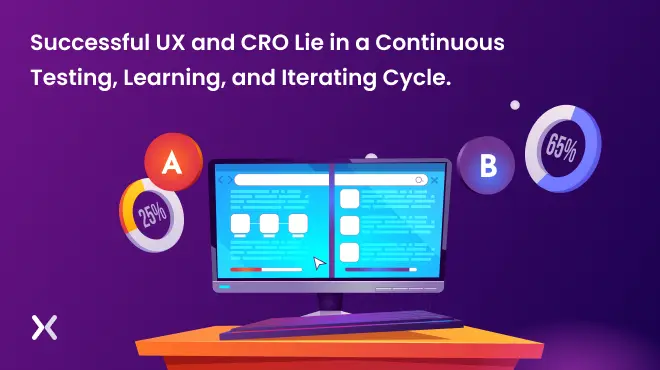
As you gather data from these tests, analyze the results and identify patterns, trends, or insights that can inform your ongoing optimization efforts. Use this information to refine your website and landing page even more, seizing any new opportunities that come from the testing process.
Successful UX and CRO lie in a continuous testing, learning, and iterating cycle. Evaluating the impact of your changes and making data-driven adjustments make it more likely your page will stay user-centric.
Achieving lasting success with CRO and UX integration is within reach when you partner with the right team of experts. We are Apexure, a leading conversion-focused web design agency specializing in crafting high-converting landing pages and websites seamlessly combining the best of CRO and UX principles.
With our data-driven approach and deep understanding of user behavior, the Apexure team can help you create a bespoke, user-centric online experience. Forget the “best practices” rabbit hole - set the stage for long-term success, and get in touch with us today!
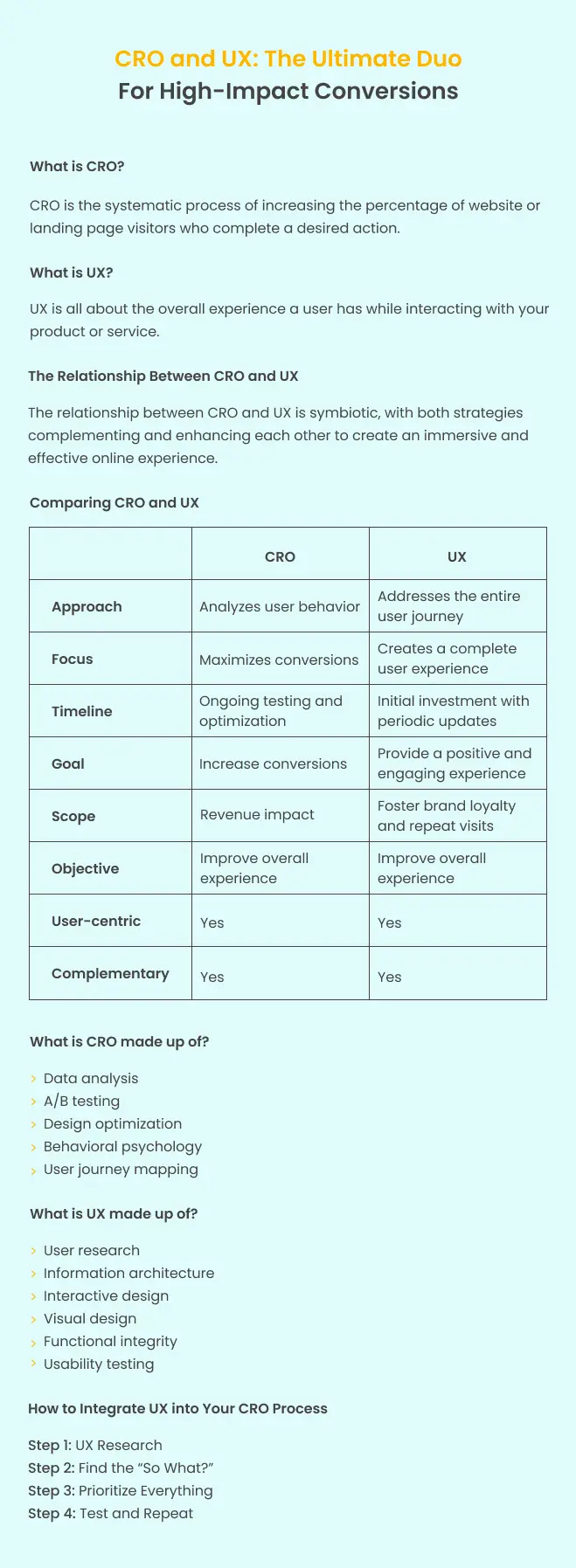
Related Article:
Drive More Sales or Leads With Conversion Focused Websites and Landing Pages
Get Started
In today’s fast-paced digital world, having a responsive website is no longer just a nice-to-have, it’s essential. Whether...
As artificial intelligence continues to evolve, businesses are finding innovative ways to enhance their marketing efforts. One of...
Get quality posts covering insights into Conversion Rate Optimisation, Landing Pages and great design